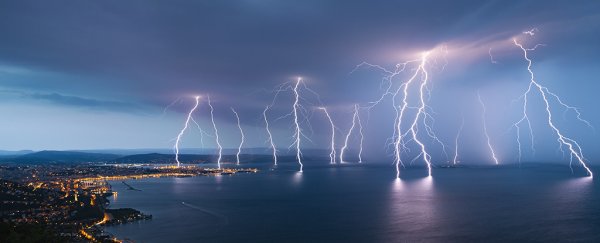For the first time, scientists have clearly linked together two types of gamma-ray phenomena in thunderclouds, suggesting that weak bursts of gamma-ray activity might precede lightning flashes in certain conditions.
The two phenomena in question are weak emissions called gamma-ray glows, which last about a minute, and much shorter and more intense terrestrial gamma-ray flashes (TGFs).
Both are known to happen inside thunderclouds, depending on the various positive and negative electrical charges around them, brought on by accelerating electrons. But scientists have never fully understood how the two gamma ray phenomena work together or their link to lightning.
Now they've been observed together with a lightning strike – opening up a whole new level of understanding when it comes to the crazy supercharged physics that are happening inside a thunderstorm.
"During a winter thunderstorm in Kanazawa, our monitors detected a simultaneous TGF and lightning strike," says astrophysicist Yuuki Wada, from the University of Tokyo in Japan. "This is fairly common, but interestingly we also saw a gamma-ray glow in the same area at the same time."
"Furthermore, the glow abruptly disappeared when the lightning struck. We can say conclusively the events are intimately connected and this is the first time this connection has been observed."
While scientists have known for decades that gamma-ray activity could accompany thunderstorms – brought on by passing electrons interacting with the nuclei of nitrogen atoms – these two types of event have only been detected together once before, and with less conclusive readings.
This time around there's no doubt, the researchers say, describing it as the first "unequivocal simultaneous detection" of the two events at sea level. However, there's still a lot more to learn about exactly what's going on.
The new findings are part of ongoing research by a collaboration called the Gamma-ray Observation of Winter Thunderclouds (GROWTH). The team works with a series of monitors installed on schools and other buildings in Kanazawa, in Ishikawa Prefecture.
With thunderclouds naturally brought low to the ground by the surrounding topography, it's the perfect place to study what's going on inside them. The portable monitors compromise both a scintillation crystal to detect ionising radiation, and two photomultiplier tubes that can turn photons into an electrical (and readable) signal.
Interestingly, the researchers say there's the possibility that gamma-ray glows don't just precede lightning strikes, but actually help cause them. Another one of the many mysteries that remain to be solved is why TGFs happen so rarely alongside lightning strikes, and exactly what prompts them to occur.
Further study, and the installation of more radiation sensors, should get scientists closer to being able to answer these questions – and might also help meteorologists predict lightning strikes with greater accuracy.
"With more sensors, we could greatly improve predictive models," says Wada. "It's hard to say right now, but with sufficient sensor data, we may be able to predict lightning strikes within about 10 minutes of them happening and within around two kilometres [1.24 miles] of where they happen."
The research has been published in Communications Physics.
